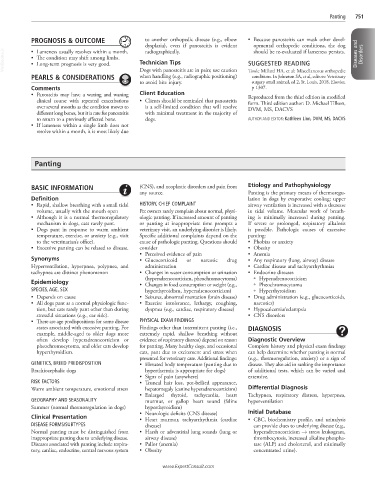Page 1475 - Cote clinical veterinary advisor dogs and cats 4th
P. 1475
Panting 751
PROGNOSIS & OUTCOME to another orthopedic disease (e.g., elbow • Because panosteitis can mask other devel-
dysplasia), even if panosteitis is evident opmental orthopedic conditions, the dog
VetBooks.ir • The condition may shift among limbs. Technician Tips SUGGESTED READING Diseases and Disorders
radiographically.
should be re-evaluated if lameness persists.
• Lameness usually resolves within a month.
• Long-term prognosis is very good.
when handling (e.g., radiographic positioning)
PEARLS & CONSIDERATIONS Dogs with panosteitis are in pain; use caution Towle Millard HA, et al: Miscellaneous orthopedic
conditions. In Johnston SA, et al, editors: Veterinary
to avoid bite injury. surgery small animal, ed 2, St. Louis, 2018, Elsevier,
Comments p 1307.
• Panosteitis may have a waxing and waning Client Education Reproduced from the third edition in modified
clinical course with repeated exacerbations • Clients should be reminded that panosteitis form. Third edition author: D. Michael Tillson,
over several months as the condition moves to is a self-limited condition that will resolve DVM, MS, DACVS
different long bones, but it is rare for panosteitis with minimal treatment in the majority of
to return to a previously affected bone. dogs. AUTHOR AND EDITOR: Kathleen Linn, DVM, MS, DACVS
• If lameness within a single limb does not
resolve within a month, it is most likely due
Panting
BASIC INFORMATION (CNS), and neoplastic disorders and pain from Etiology and Pathophysiology
any source. Panting is the primary means of thermoregu-
Definition lation in dogs by evaporative cooling; upper
• Rapid, shallow breathing with a small tidal HISTORY, CHIEF COMPLAINT airway ventilation is increased with a decrease
volume, usually with the mouth open Pet owners rarely complain about normal, physi- in tidal volume. Muscular work of breath-
• Although it is a normal thermoregulatory ologic panting. If increased amount of panting ing is minimally increased during panting.
mechanism in dogs, cats rarely pant. or panting at inappropriate time prompts a If severe or prolonged, respiratory alkalosis
• Dogs pant in response to warm ambient veterinary visit, an underlying disorder is likely. is possible. Pathologic causes of excessive
temperature, exercise, or anxiety (e.g., visit Specific additional complaints depend on the panting:
to the veterinarian’s office). cause of pathologic panting. Questions should • Phobias or anxiety
• Excessive panting can be related to disease. consider • Obesity
• Perceived evidence of pain • Anemia
Synonyms • Glucocorticoid or narcotic drug • Any respiratory (lung, airway) disease
Hyperventilation, hyperpnea, polypnea, and administration • Cardiac disease and tachyarrhythmias
tachypnea are distinct phenomenon • Changes in water consumption or urination • Endocrine diseases
(hyperadrenocorticism, pheochromocytoma) ○ Hyperadrenocorticism
Epidemiology • Changes in food consumption or weight (e.g., ○ Pheochromocytoma
SPECIES, AGE, SEX hyperthyroidism, hyperadrenocorticism) ○ Hyperthyroidism
• Depends on cause • Seizures, abnormal mentation (brain disease) • Drug administration (e.g., glucocorticoids,
• All dogs pant as a normal physiologic func- • Exercise intolerance, lethargy, coughing, narcotics)
tion, but cats rarely pant other than during dyspnea (e.g., cardiac, respiratory disease) • Hypocalcemia/eclampsia
stressful situations (e.g., car ride). • CNS disorders
• There are age predispositions for some disease PHYSICAL EXAM FINDINGS
states associated with excessive panting. For Findings other than intermittent panting (i.e., DIAGNOSIS
example, middle-aged to older dogs more extremely rapid, shallow breathing without
often develop hyperadrenocorticism or evidence of respiratory distress) depend on reason Diagnostic Overview
pheochromocytoma, and older cats develop for panting. Many healthy dogs, and occasional Complete history and physical exam findings
hyperthyroidism. cats, pant due to excitement and stress when can help determine whether panting is normal
presented for veterinary care. Additional findings: (e.g., thermoregulation, anxiety) or a sign of
GENETICS, BREED PREDISPOSITION • Elevated body temperature (panting due to disease. They also aid in ranking the importance
Brachiocephalic dogs hyperthermia is appropriate for dogs) of additional tests, which can be varied and
• Signs of pain (anywhere) extensive.
RISK FACTORS • Truncal hair loss, pot-bellied appearance,
Warm ambient temperature, emotional stress hepatomegaly (canine hyperadrenocorticism) Differential Diagnosis
• Enlarged thyroid, tachycardia, heart Tachypnea, respiratory distress, hyperpnea,
GEOGRAPHY AND SEASONALITY murmur, or gallop heart sound (feline hyperventilation
Summer (normal thermoregulation in dogs) hyperthyroidism)
• Neurologic deficits (CNS disease) Initial Database
Clinical Presentation • Heart murmur, tachyarrhythmia (cardiac • CBC, biochemistry profile, and urinalysis
DISEASE FORMS/SUBTYPES disease) can provide clues to underlying disease (e.g.,
Normal panting must be distinguished from • Harsh or adventitial lung sounds (lung or hyperadrenocorticism → stress leukogram,
inappropriate panting due to underlying disease. airway disease) thrombocytosis, increased alkaline phospha-
Diseases associated with panting include respira- • Pallor (anemia) tase (ALP) and cholesterol, and minimally
tory, cardiac, endocrine, central nervous system • Obesity concentrated urine).
www.ExpertConsult.com

